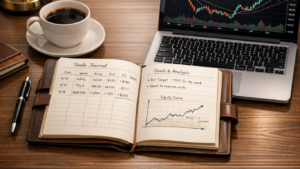Did you know? 90% of traders lose money, not because of poor strategies, but due to a lack of discipline.
If you’re trading in today’s volatile markets, staying disciplined can be your biggest edge. Here’s what you need to know:
- Why Discipline Matters: Emotional decisions driven by fear or greed can wipe out months of gains in minutes.
- Key Risk Management Tools: Use position sizing (e.g., ATR-based), stop-loss strategies, and diversification to protect your capital.
- Psychology of Volatility: Manage emotions like panic selling or FOMO with a clear trading plan, mindfulness, and journaling.
- Trading Plan Essentials: Define your goals, set risk-reward ratios (e.g., 1:3), and use clear entry/exit strategies.
- Tech Tools: Automated systems, real-time analysis platforms, and volatility indicators like ATR and VIX can help you stay objective.
Quick Comparison: Volatility Indicators
| Indicator | Use Case | Key Signal | Settings |
|---|---|---|---|
| ATR | Stop-loss & position sizing | Low readings = possible breakout | 14 periods |
| Bollinger Bands | Overbought/oversold levels | Bands widen in high volatility | 20-period MA, 2 deviations |
| VIX | Gauging market sentiment | Above 30 = high volatility | N/A |
| Donchian Channels | Breakout signals | Prices hitting channel extremes | 20 periods |
Takeaway: Success in volatile markets depends on preparation, risk management, and emotional discipline. Stick to your plan, utilise tech tools, and turn market chaos into opportunity.
Understanding Volatility and How It Affects Trader Psychology
What Is Market Volatility
Market volatility refers to the extent and frequency of price changes in a financial market. Simply put, it’s how much and how often prices swing. A highly volatile stock might see wild price movements, reaching new highs and lows or fluctuating erratically within short periods.
From a technical perspective, volatility measures the variability in a security or market index’s returns. When volatility is high, prices can shift dramatically in a short timeframe. On the other hand, low volatility suggests more stable price movements.
“Volatility is an investment term that describes when a market or security experiences periods of unpredictable, and sometimes sharp, price movements.” – Fidelity International
Several tools help measure volatility. Standard deviation tracks how much a security’s price deviates from its average, while beta compares a security’s volatility to the overall market. The CBOE Volatility Index (VIX) is another popular metric, offering insights into the expected volatility of the S&P 500.
For Singapore traders keeping an eye on global markets, the VIX provides useful benchmarks:
| VIX Value | Market Indication |
|---|---|
| 0–15 | Low volatility, market optimism |
| 15–25 | Moderate volatility, nothing extreme |
| 25–30 | Rising turbulence, increasing volatility |
| 30 and over | High volatility, extreme price swings likely |
Historically, the VIX has averaged just above 20. Traders often consider values above 30 as a sign of high volatility, while readings below 20 suggest a calmer market environment. By analysing these metrics, traders can evaluate past price movements to anticipate future trends. Historical volatility, in particular, helps them gauge the risk involved in potential trades.
Understanding these technical aspects is just the first step. The next challenge is grappling with how volatility impacts trader emotions.
How Emotions React to Market Swings
Volatility doesn’t just affect prices – it profoundly influences trader behaviour. Uncertainty and rapid market changes can trigger emotional responses that derail even the most carefully crafted strategies. Studies show that more than one in three traders experience frustration and disappointment when facing losses, with 32% identifying these as their dominant reactions. Such emotions often cloud judgment before rational learning can occur.
“These emotions can distort rational decision-making by activating the amygdala, prompting impulsive actions and clouding judgement during periods of market volatility.” – James Roy, neuro expert at Brainworks Neurotherapy
Age also plays a role in how traders react emotionally. Investors aged 41–60 are the most emotionally influenced, with 35.4% acknowledging that emotions frequently guide their decisions. For 20% of all traders, emotions play a significant role in their choices, and for nearly 3%, emotions are a constant factor. The emotional rollercoaster during volatile times includes fear, greed, anxiety, overconfidence, frustration, and disappointment. For instance, fear often leads to panic selling during market downturns, while greed and overconfidence can dominate in bullish markets.
A historical example of volatility’s impact is the dot-com bubble. The Nasdaq soared fivefold before crashing by 76.81%, leaving countless investors with devastating losses.
Managing emotions is a critical skill for traders. As Professor Krupa Desai of SNHU points out:
“Understanding investors’ mindsets and behaviours is an interesting and integral part of studying the stock market. Investors are often driven by emotions like fear and greed, which can lead to market anomalies and inefficiencies.” – Professor Krupa Desai, SNHU faculty
Trading Psychology – Mastering Discipline and Emotions 13.04.2025
Risk Management Principles for Volatile Markets
In unpredictable markets, protecting your capital should always be your top priority. Volatile conditions can quickly wipe out gains, making robust risk management essential. Strategies that perform well in steady markets often falter when prices swing wildly, so traders need to adjust their approach to navigate these challenges effectively. Let’s dive into how position sizing, stop-loss strategies, and diversification can help you stay in control during volatile times.
Adjusting Position Sizes
Position sizing becomes a critical tool during periods of market turbulence. As Brijesh Bhatia, Equity Capital Market Analyst at Definedge, aptly states:
“Position sizing is the glue that holds together a sound trading system”.
One effective method is the Average True Range (ATR) position sizing, which adjusts positions based on current market volatility. This approach ensures consistent risk exposure, even when markets are unpredictable. For example, during high-volatility periods with an ATR of S$4, this method might limit your position to 125 shares. In contrast, during calmer times with an ATR of S$1, it could allow for up to 500 shares.
If you have a S$100,000 account and a 5% maximum drawdown tolerance, ATR sizing can help you manage trades in assets like Bitcoin, where daily price swings can hit 20%. For instance, entering at S$60,000 with a stop at S$58,000, drawdown-based sizing would automatically adjust your position to shield against extreme price fluctuations.
Here’s a quick comparison of common position sizing methods:
| Method | Risk Control | Volatility Response | Key Feature |
|---|---|---|---|
| ATR Sizing | High | Excellent | Adjusts size based on ATR |
| Fixed Risk % | Moderate | Limited | Simple calculation for risk cap |
| Drawdown-Based | High | Good | Focuses on cumulative losses |
| Variable Leverage | Moderate | Good | Modifies leverage dynamically |
| Chart Pattern | High | Excellent | Based on pattern success rates |
Combining methods, such as using ATR sizing with drawdown limits, often proves more effective than relying on a single approach. Reassess your ATR and position sizes regularly to stay aligned with market conditions.
Stop-Loss Strategies That Work
In volatile markets, fixed stop-losses can lead to premature exits. ATR-based stops, on the other hand, adjust dynamically to market conditions, giving traders the flexibility to manage risk without being shaken out by normal price fluctuations.
The ATR Trailing Stop is particularly useful, as it adapts to changing conditions while protecting profits. As the PineConnector Team explains:
“The ATR trailing stop is a valuable tool that adapts to market conditions, giving traders the flexibility to protect profits while managing risk”.
For varying levels of volatility, leverage guidelines can help you stay grounded:
| Volatility Level (ATR) | Suggested Leverage | Market Conditions |
|---|---|---|
| Less than 1% of price | Up to 10:1 | Low volatility, trending markets |
| 1–2% of price | 5:1 | Moderate volatility |
| 2–3% of price | 3:1 | High volatility |
| More than 3% of price | 1:1 or no leverage | Extreme volatility |
Daily attention to stop-loss management is crucial. Adjust ATR values based on recent market activity – using shorter periods (5–10 days) for highly volatile markets and longer ones (14–20 days) for trending conditions. Slightly widening your stop-loss by 0.5%–1% can also help account for slippage. Advanced traders often adjust stops after a favourable move, trail them during strong trends, or widen them during periods of consolidation. Always reassess before major events that could shake up the market.
Diversification During Market Swings
While position sizing and stop-losses manage individual trades, diversification spreads risk across an entire portfolio. During volatile times, spreading investments across assets with varying responses to economic events can help cushion losses. Although diversification doesn’t necessarily aim to maximise returns, it can significantly reduce portfolio losses during downturns.
Take the 2008–2009 bear market, for example. A diversified portfolio of 70% stocks, 25% bonds, and 5% short-term investments fared better than an all-stock portfolio. Similarly, a 60% stock and 40% bond mix (using the S&P 500 and Bloomberg U.S. Aggregate Bond Index) typically delivers steadier returns compared to an all-stock allocation.
Effective diversification involves spreading risk across three dimensions:
- Across asset classes: Include stocks, bonds, cash, and real assets.
- Within asset classes: Diversify across industries, maturities, and issuers.
- Geographically: Add global exposure to reduce region-specific risks.
As Ann Dowd, CFP® and vice president at Fidelity Investments, advises:
“Being disciplined as an investor isn’t always easy, but over time it has demonstrated the ability to generate wealth, while market timing has proven to be a costly exercise for many investors”.
Don’t forget to rebalance your portfolio regularly, especially after significant market movements that may have altered your allocations. Keep an eye on systematic risks like inflation, interest rate changes, or geopolitical events, as these can impact multiple asset classes. Understanding the correlation between securities is key to building a portfolio that can weather market volatility.
Building and Following a Trading Plan for Volatile Markets
Navigating volatile markets without a solid trading plan is like sailing through a storm without a compass. A well-thought-out plan not only keeps you grounded but also helps you make informed decisions instead of reacting emotionally to sudden market shifts.
Key Parts of a Volatility Trading Plan
A good trading plan answers three critical questions: what to trade, when to trade, and how much to trade. During volatile times, certain elements become even more crucial for maintaining consistency.
Clear Trading Objectives and Goals
Start by defining your trading goals using SMART criteria – specific, measurable, attainable, relevant, and time-bound. Ask yourself: Are you trading to supplement your income, or is this part of a long-term wealth-building strategy? Also, consider how much time you can realistically dedicate to trading. Whether you can spare a few hours daily or only weekends for analysis, your goals and availability will shape your entire approach.
Risk Management Framework
Managing risk is non-negotiable in volatile markets. Many experienced traders stick to a risk-reward ratio of at least 1:3, meaning they’re willing to risk S$1 for the chance to gain S$3. For instance, Charles Schwab highlighted in January 2023 that a trader with S$150,000 in capital might allocate up to 5% (S$7,500) to a single position and cap their potential loss at 1% (S$1,500) per trade.
Market Selection and Strategy Definition
Focus on markets you understand well. During volatile periods, short-term strategies like day trading or swing trading often work better than holding positions for months.
Entry and Exit Criteria
Establish clear rules for entering and exiting trades. Define your position sizes, set profit targets, and use trailing stops to protect gains.
Record Keeping System
Keep a detailed trading journal. Document your trades, the reasoning behind them, and even your emotions during the process. This habit provides valuable insights for improving your strategy over time.
| Plan Component | Volatile Market Focus | Example Parameters |
|---|---|---|
| Position Size | Smaller sizes to limit risk | Maximum 2–3% of capital per trade |
| Stop-Loss Placement | Wider stops to avoid whipsaws | 1.5–2× normal ATR distance |
| Profit Targets | Take profits more quickly | 15–20% gains vs. 30–40% in calm markets |
| Time Horizon | Shorter holding periods | Days to weeks instead of months |
Once your plan is ready, preparation is the next step to ensure it works effectively.
Preparing Before You Trade
Preparation is the foundation of success in turbulent markets. As Luckbox analyst-at-large Andrew Prochnow wisely points out:
“In volatile markets, fortune favours the prepared – those with a well‑defined approach to both risk and opportunity”.
Market Research and Analysis
Stay informed about key economic indicators, central bank actions, and breaking news. Volatile markets often react sharply to unexpected developments, so it’s essential to monitor multiple sources of information. Use alerts to stay updated on economic releases or company announcements that might affect your positions.
Strategy Testing and Validation
Before committing real money, thoroughly test your trading strategies. Focus on stocks moving in line with market trends, as they’re more likely to yield quicker profits during volatile times. Look for breakout opportunities and always use stop-loss orders to limit potential losses.
Mental and Emotional Preparation
Trading in a volatile environment can be stressful. Accept that larger daily swings and faster decision-making are part of the game. Prepare yourself mentally for potential losses and understand that psychological resilience is key to navigating market turbulence.
Technical Setup
Set up your trading platform with pre-configured orders for entries, exits, and stop-loss levels. Automating these processes allows you to respond quickly to market movements without scrambling to place manual orders.
Once you’ve prepared your strategy and tools, the next challenge is to stick to your plan.
Sticking to Your Plan
A trading plan is only effective if you follow it consistently. When volatility spikes, discipline becomes your greatest ally.
Removing Emotional Decision-Making
Stick to the fundamentals and avoid impulsive reactions. Prepare thoroughly in advance, so you’re not caught off guard when markets move against you. Follow your exit rules, even when it’s tempting to hold on longer.
Order Management Discipline
Use limit buy orders to enter positions during market dips. Combine this with stop-loss and take-profit orders to manage risk and secure gains automatically. This systematic approach helps you avoid emotional overrides.
Position Monitoring and Adjustment
Keep an eye on your positions and adjust only when necessary. Over-managing can lead to mistakes, so trust the rules you’ve set for position sizes and stop-loss adjustments.
Maintaining Long-Term Perspective
Missing key trading days can significantly impact your returns. Between 1961 and 2015, missing just the 25 best trading days for the S&P 500 would have slashed the average annual return from 9.87% to 5.74%. This highlights the importance of staying disciplined, even during difficult periods.
If market stress becomes overwhelming, consider reducing your position sizes or even using dollar-cost averaging to maintain consistency. Alternatively, focus on paying down debt or reassessing your goals. Regularly reviewing your risk tolerance and documenting your objectives can help you stay on track.
Master Systematic Trading with Collin Seow
Learn proven trading strategies, improve your market timing, and achieve financial success with our expert-led courses and resources.
Technical Tools and Strategies for Volatile Markets
Navigating volatile markets requires a mix of technical tools and well-thought-out strategies. These help traders identify opportunities and manage risks, ensuring that decisions about when to enter or exit trades are guided by data rather than emotion.
Volatility Indicators
Measuring market volatility accurately is the first step towards understanding it. Volatility indicators provide insights into periods of high and low volatility, which are especially useful when price trends alone fail to tell the full story.
Average True Range (ATR)
ATR calculates how much a stock typically moves over a specific period, usually 14 days. Unlike simple price changes, ATR also accounts for gaps between trading sessions, offering a clearer picture of volatility. For instance, if a stock’s ATR is S$2.50, you could set a stop-loss at 1.5 to 2 times that value, or between S$3.75 and S$5.00, to manage risk effectively.
Bollinger Bands
These bands show when prices deviate significantly from their average. During high volatility, the bands widen, while calmer periods see them contract. In an uptrend, the lower band can act as a trailing stop-loss, adjusting as the trend progresses. Conversely, prices touching the upper band might indicate overbought conditions, while the lower band may signal oversold levels.
CBOE Volatility Index (VIX)
Often called the “fear index”, the VIX reflects the expected volatility of the S&P 500 over the next 30 days. Generally, values between 12 and 35 are common, with spikes above 30 suggesting heightened market fear and potential buying opportunities.
Donchian Channels
These channels track the highest and lowest prices over a set period, generating buy or sell signals when prices hit these extremes. Additionally, comparing current standard deviation values with historical data can help identify whether the market’s current volatility is unusually high or low.
| Indicator | Best Used For | Typical Settings | Key Signal |
|---|---|---|---|
| ATR | Stop-losses and position sizing | 14 periods | Low readings may signal a breakout |
| Bollinger Bands | Overbought/oversold identification | 20-period MA, 2 deviations | Prices touching the bands |
| VIX | Gauging market sentiment | N/A (index value) | Values above 30 = high volatility |
| Donchian Channels | Breakout signals | 20 periods | Prices reaching channel extremes |
These indicators are particularly helpful for short-term trading, offering clarity on market conditions during unpredictable periods.
Short-Term Trading Strategies
Volatile markets can be a playground for traders who thrive on quick decisions. However, success depends on aligning strategies with your skills, temperament, and time availability.
Day Trading Approach
Day trading involves capitalising on intraday price movements, with trades lasting minutes to hours. This approach requires mental discipline and the ability to make fast decisions under pressure. According to FINRA, a pattern day trader executes four or more day trades within five business days, making up over 6% of their total trades. To succeed, combine technical tools like moving averages and Bollinger Bands with robust risk management practices, such as stop-loss orders and proper position sizing.
Scalping Strategy
Scalping focuses on making many small trades to profit from minor price fluctuations. Positions are held for seconds to minutes, demanding constant market monitoring and quick reflexes. While the stress can be intense, the cumulative gains from numerous small wins can add up for those dedicated to this approach.
Swing Trading Adjustments
Traditional swing trading spans days to weeks, but in volatile markets, it can be adapted to focus on larger intraday moves. Closing positions before the market closes helps avoid overnight risk. This strategy works best for traders with a clear plan, including entry and exit rules, risk parameters, and profit targets.
When directional trades become tricky, non-directional strategies can provide alternative ways to profit.
Non-Directional Trading Methods
In volatile markets, strategies like straddles and strangles allow traders to benefit from price movements without needing to predict the direction.
Long Straddle Strategy
This involves buying both a call and a put option at the same strike price and expiration date. The success of this strategy depends on the magnitude of price movement, not its direction. For example, a straddle at S$70 might cost S$2.80 (S$1.40 each for the call and put). Profit occurs when the price moves significantly beyond the breakeven points, but if the price remains at the strike price at expiration, the entire investment could be lost.
Long Strangle Strategy
Strangles are similar to straddles but use different strike prices for the call and put options. For instance, a strangle with a S$68 put and S$72 call might cost S$1.40. While typically cheaper than straddles, strangles require a larger price movement to be profitable, making them riskier if the price remains between the strike prices at expiration.
Implementation Tips
To maximise success with straddles or strangles:
- Use limit orders to secure favourable prices.
- Monitor implied volatility, as it heavily impacts option pricing.
- Be mindful of time decay, which reduces option value as expiration nears.
- Consider stop-loss orders for short positions to limit losses.
- Stay flexible, adjusting positions as market conditions change.
- Evaluate the impact of time decay and implied volatility, especially before major events like earnings reports.
Options trading carries significant risk, including the potential for a 100% loss on long options. It’s crucial to approach these strategies with discipline and a clear understanding of the risks involved.
These tools and strategies provide a structured way to approach volatile markets. For further learning, check out the courses, live webinars, and free resources available at Collin Seow Trading Academy.
Managing Emotions and Staying Disciplined
When markets get volatile, emotions can swing wildly, often disrupting disciplined trading. Studies indicate that 73% of active traders face high stress during such periods, yet those who factor in emotional awareness alongside long-term trends see a 23% boost in profitability. Below are practical strategies to help you manage emotions and stay focused when markets become unpredictable.
Methods for Controlling Emotions
The first step in managing trading emotions is to acknowledge them. Feelings like fear, greed, hope, regret, and ego can easily derail your decisions. Recognising these emotions is key to staying in control.
Stick to Your Trading Plan
A solid trading plan is your safety net. It not only manages risk but also keeps your emotions in check. When the market feels chaotic, your plan acts as a guide to prevent impulsive actions.
“My worst trades – and there have been a few of them – have all been when my best laid plans are thrown out of the window when I lose discipline.”
- Nick Cawley, DailyFX analyst
Tune Out the Noise
Constant updates from the news and social media can amplify emotional reactions. Instead, focus on objective data like technical indicators, such as moving averages, to ground your decisions.
Pause Before Acting
Brad Klontz, a financial psychologist, stresses the importance of taking a moment before making a move:
“Put some time between your impulse to act and your behaviour.”
If you feel an urge to trade immediately, take a brief pause to ensure your decision is based on logic, not emotion.
Use Breathing Exercises
When stress levels spike, a few deep breaths can help calm your mind and restore focus.
Adjust Your Trade Size
Reducing the size of your positions can make losses feel less overwhelming, helping you maintain discipline.
Maintain a Trading Journal
Documenting your trades and the emotions you experience can reveal patterns over time. This self-awareness helps you spot triggers and refine your approach.
Common Psychological Mistakes to Avoid
Stressful market conditions often lead to cognitive biases, which can result in poor decisions. Here are some common pitfalls and how to avoid them:
Overconfidence Bias
A streak of wins can lead to overconfidence, causing traders to ignore critical data, take on excessive risk, or bypass proper analysis.
Loss Aversion
Holding onto losing positions in the hope of a recovery, or exiting winning trades too early, can disrupt your strategy. Recognising this tendency allows for more balanced decisions.
Herd Mentality
Following the crowd often means buying at market peaks or selling at lows. Independent analysis of market fundamentals is a better approach.
FOMO Trading
The fear of missing out can lead to chasing trends without proper research, often resulting in poorly timed trades.
Revenge Trading
Trying to recover losses by taking bigger risks can lead to even greater setbacks.
| Emotion | Typical Behaviour | Warning Signs |
|---|---|---|
| Fear | Closing winning trades too soon, hesitating on solid setups | Constantly checking charts, scaling down positions unnecessarily |
| Greed | Ignoring stop-losses, doubling down on losses | Breaking position size rules, chasing trades |
| Overconfidence | Taking large risks, skipping proper analysis | Skipping trade plans, using excessive leverage |
By recognising these behaviours, you can take steps to build emotional resilience.
Building Resilience Through Practice
Developing emotional resilience is an ongoing process that involves practice and reflection.
Adopt a Growth Mindset
Treat losses and mistakes as opportunities to learn rather than failures. This mindset helps you recover more quickly from setbacks.
Set Realistic Goals
Understand that consistent profits take time, and market fluctuations are part of the process. Realistic expectations can prevent frustration and impulsive decisions.
Incorporate Mindfulness and Meditation
Even a few minutes of mindfulness or meditation each day can sharpen your focus and reduce impulsive actions.
Establish Healthy Trading Habits
Create a structured routine for trading. Setting specific trading hours, taking regular breaks, and maintaining a work-life balance can reinforce discipline over time.
Build a Support Network
Engage with mentors, trading communities, or professional counsellors to gain insights and share challenges. External feedback can help you recognise emotional patterns you might not notice on your own.
Track Emotional Triggers
Go beyond keeping a trading journal by actively monitoring the conditions – market events, news, or personal situations – that tend to spark impulsive decisions.
Traders who adopt these strategies report 57% lower cortisol levels during volatile periods, and those who regularly use stop-loss orders experience a 65% reduction in emotional reactions during downturns.
Keep Evolving
Markets are constantly changing, and so should your strategies for managing emotions. Regularly review your performance, identify areas for improvement, and adjust your approach as needed.
While building emotional resilience requires effort and time, the benefits go beyond better trading results – they contribute to your overall well-being. For more resources on trading discipline and emotional management, check out the educational materials at Collin Seow Trading Academy.
Using Technology for Better Trading Discipline
Technology has transformed the way traders approach discipline in volatile markets. Today, automated trading systems dominate the landscape, accounting for up to 78% of all stock market trades and as much as 90% of short-term and crypto trades. In this fast-paced environment, technology is no longer optional – it’s essential for maintaining discipline.
One of the biggest advantages of technology in trading is its ability to remove emotions from decision-making. As James Buchman from ninZa.co aptly says:
“Automated trading takes the emotion out of trading.”
And this is crucial – emotional trading often leads to impulsive decisions, which are a primary cause of losses.
Automated Trading Tools
Automated trading systems play a critical role in fostering discipline. These systems execute trades based on pre-set rules, ensuring that decisions remain objective, even during volatile market conditions. By configuring these systems with clear objectives – like profit targets and risk tolerance – you can ensure that logic always takes precedence over emotion.
For example, position sizing calculators help align your trade size with your risk parameters, while automated stop-loss orders protect you from the temptation to hold onto losing positions. Backtesting strategies using historical data is another key feature, helping you build confidence in your trading system. Regular monitoring of these algorithms ensures they stay relevant as market conditions evolve.
Information and Analysis Platforms
Technology doesn’t just help with trade execution – it’s also invaluable for data analysis and decision-making. With millions of trades happening daily on platforms like the New York Stock Exchange and Nasdaq, having access to real-time, accurate information is non-negotiable.
Tools offering real-time market analysis – complete with advanced charting, technical indicators, and backtesting capabilities – help traders make informed decisions based on current market conditions rather than emotional impulses. Platforms like TrendSpider, Trade Ideas, and TradingView are particularly popular, with user ratings of 4.8/5 and 4.7/5, respectively. Barry D. Moore, a Certified Financial Technician, describes TrendSpider as:
“Unlike anything I have seen before, TrendSpider employs artificial intelligence to detect trends not seen by humans. I have met Dan and his team, and I can assure you this platform is the most innovative in the industry, led by a man with great integrity.”
Economic calendars and integrated news feeds keep traders updated on market-moving events, while avoiding information overload. Additionally, AI-powered technical analysis software can uncover patterns and trends that might escape the human eye. Sentiment analysis tools, which scan news and social media, offer insights that go beyond traditional financial indicators.
When selecting a trading platform, look for user-friendly interfaces, customisation options, and advanced technologies like AI integration. It’s also important to find a platform that fits your budget. For traders in Singapore, basic TradingView plans start at about S$17 per month, while more premium options like eSignal‘s Elite can cost around S$592 per month.
Conclusion: Mastering Trading Discipline in Volatile Markets
Trading discipline goes beyond simply following a set of rules – it’s the backbone that distinguishes successful traders from the majority who quit within three years. Research highlights that emotions like fear and greed account for 65% of trading mistakes that lead to losses, while trading psychology plays a massive role, influencing 80% of market success.
To succeed in trading, you need to focus on three key areas: preparation, risk management, and psychological discipline. Preparation means starting your day with a sharp pre-market review and an honest self-assessment. Risk management involves practical tools like stop-loss orders, proper position sizing, and diversification to safeguard your capital during turbulent market conditions. Psychological discipline is about keeping emotions in check – whether through mindfulness, meditation, or simply sticking to your trading plan, no matter how chaotic the market feels. These elements, when combined, form a solid strategy for navigating volatile markets.
Missing out on critical market movements can significantly impact returns. Take March 2020 as an example: the S&P 500 plunged 12% but then surged by 69% within a year. Traders who maintained discipline and followed their plans likely capitalised on this recovery, while those who gave in to panic missed the opportunity.
Developing discipline starts with small, consistent habits. Begin each trading session with a clear head, review your decisions regularly, and keep a journal of your trades to track progress and learn from mistakes. As Vanguard founder John Bogle aptly put it:
“Investing is not nearly as difficult as it looks. Successful investing involves doing a few things right and avoiding serious mistakes.”
By applying these principles, you can turn market volatility into an opportunity. The goal isn’t to achieve perfection but to maintain consistency. Stick to your plan, manage risks effectively, and treat each trade as a learning experience. In uncertain markets, your discipline becomes your edge, providing the structure you need to thrive.
For traders in Singapore aiming to sharpen their strategies, Collin Seow Trading Academy offers a range of courses and resources tailored to disciplined trading. Their systematic approach, including tools like “The Systematic Trader v.2”, equips traders with the skills and knowledge to succeed in even the most volatile markets.
FAQs
How can I stay emotionally disciplined when trading in volatile markets?
Managing your emotions is crucial for staying disciplined and making rational decisions, especially in volatile markets. Emotional responses like fear or greed can push you toward impulsive actions, such as panic selling or excessive trading. To keep a level head, start by crafting a detailed trading plan. Define your entry and exit points clearly, use stop-loss orders to limit potential losses, and diversify your portfolio to spread risk. These strategies can help reduce emotional triggers and keep you on track.
Equally important is developing emotional resilience. Techniques like mindfulness practices – whether it’s deep breathing, meditation, or simply taking a moment to pause – can help you stay composed during high-pressure situations. Regularly reviewing your trading decisions is another way to spot patterns and areas for growth. Staying updated on Singapore’s market trends and key economic indicators can also give you a better sense of what to expect, helping you navigate volatility with more confidence. By integrating these approaches, you can sharpen your focus and trade with greater assurance.
What should I include in a trading plan to stay disciplined during volatile markets?
A solid trading plan is essential for maintaining discipline and managing risks, especially in unpredictable markets. Here’s what you should prioritise:
- Set Clear Objectives: Outline your trading goals, expected results, and timelines. Having a clear plan helps you avoid impulsive decisions during market fluctuations.
- Manage Your Risk: Determine position sizes based on your capital and risk tolerance. Use tools like stop-loss orders to cap potential losses, particularly in volatile scenarios.
- Analyse the Market: Stick to consistent criteria for choosing trades, whether through technical indicators, fundamental analysis, or both. Keep a curated watchlist of assets that align with your strategy.
- Control Your Emotions: Focus on your long-term objectives and don’t let fear or greed dictate your actions. Adopt techniques to stay calm and level-headed, even when markets get rough.
Incorporating these elements can help you stay disciplined and make smarter trading decisions, no matter how volatile the market gets.
How can technology and automated tools help traders stay disciplined and avoid emotional decisions during volatile markets?
Technology and automated trading tools have become essential for helping traders maintain discipline, especially during unpredictable market swings. These tools rely on pre-set algorithms to execute trades, cutting out emotional responses like fear or greed that often lead to rash decisions. The result? Trades are carried out in a more objective and systematic manner.
One of the standout benefits of automated systems is their ability to enforce risk management through stop-loss and take-profit levels. By setting these parameters in advance, traders ensure their strategies are consistently applied, no matter the market conditions. With the technical aspects handled by automation, traders can shift their focus to fine-tuning strategies and staying mentally clear – key factors for achieving steadier results over time.












